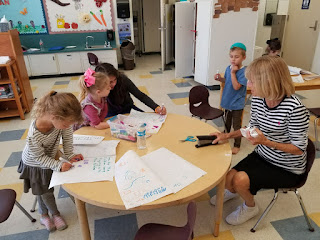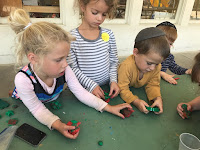Yom Kippur was our main focus this week!
We learned a song to highlight a lot of important information.
"On Yom Hakippurim
No eating and no drinking
no leather shoes, no washing
until after Neilah
The locking of Tefilah."
The children were so excited when Morah Davina told them that their Mommies and Daddies could watch a video of them singing.
Morah Avigayil used visual aids to teach the children what they are not allowed to do on Yom Kippur
"Overheard in Kindergarten"- On Yom Kippur I'm going to give my mommy a massage to help her feel better from fasting- Muka H.
 |
| Yom Kippur is a very serious day because Hashem is judging us and we are fasting. Kindergarten gets ready for Yom Kippur, with a serious davening in our shul as well. |
Yom Kippur also is a very happy day because we are given the chance to fix our mistakes and do better. Kindergarten practiced happy davening
Treasuring our good Middos and throwing out the bad
We sorted pictures into good and bad action categories and made treasure boxes to keep all the good actions in. Kindergarten is always on the look out to do more mitzvos!

On Yom Kippur we are cleaning our soul ,while kindergarten was cleaning the classroom we were thinking about the Midddos we want to get rid of, cleaning away on Yom Kippur.

On Yom Kippur we are cleaning our soul ,while kindergarten was cleaning the classroom we were thinking about the Midddos we want to get rid of, cleaning away on Yom Kippur.
Language Arts
Elizabeth focuses intently on her work
Library Learning
Morah Malka read one of our favorite books during lunchtime. Kindergarten was so inspired from the book Library Mouse by Daniel Kirk , we decided to author and illustrate our own books!
*ask your child what word we use for the person who draws the pictures in books*
Math
Yisroel working on his number recognition and fine motor skills.
* ask your child to show you his/her pincher fingers*
Sensory Math Center


Sensory Alef Bet Writing
Using paint in ziplock the children were invited to copy the shapes of the hebrew letters.
Muka and Menucha practice the shapes of a Bais and Vov respectively.
This week we learned that a Vais and a Vav have the same sound but are different letters.














































